THE MYRRORS
ENTRANCED MUSIC
di Giampiero Fleba
Sulle tracce dei Myrrors di Tucson (Arizona). Dal deserto di Sonora lungo le strade del mondo tra America del Sud, Europa ed Asia. Un viaggio in movimento dal 2007 sugli sviluppi di una ricerca appassionata nel reimmaginare l’idea di musica psichedelica per offrire spunti di riflessione e nuove coordinate del loro suono attualmente espresse da: Nik Rayne (chitarra acustica, elettrica, voce, drones) Miguel Urbina (violino), Grant Beyschau (batteria, percussioni, sax, flauto, clarinetto) e Kellan Fortier (basso). Alla vigilia del nuovo attesissimo terzo album “Entranced Earth” ripercorriamo la loro storia in questa piacevole conversazione via web con uno dei fondatori: Nik Rayne
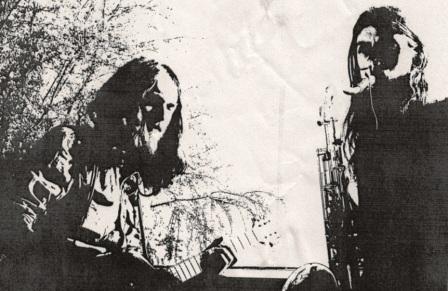 Quando vi siete formati, raccontami qualcosa dei vostri inizi e da dove nasce il nome Myrrors, l’idea di formare una band?
Quando vi siete formati, raccontami qualcosa dei vostri inizi e da dove nasce il nome Myrrors, l’idea di formare una band?
M (NR) – La band si è formata circa nove anni fa come un collettivo di amici adolescenti che erano interessati a fare musica ispirata a tutti i folli dischi psichedelici che stavamo scoprendo in quel momento. Il nome della band è stata solo una proposta infelice rimasta impressa per la nostra incapacità di pensare ad altro. Abbiamo registrato “Burning Circles in the Sky” in quel primo anno di esistenza, fondamentalmente una serie di canzoni e sperimentazioni in studio messe insieme nel tempo libero per cercare di avere un po’ di materiale strutturato da suonare dal vivo.
Da varie interviste ho letto che avete una cultura musicale notevole, frutto di una ricerca personale o innescata da 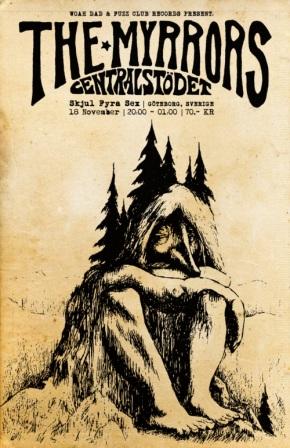 situazioni particolari? Quali sono le vostre fonti ispirative? Cosa stai ascoltando in questi giorni? Gli svedesi Hills recentemente intervistati vi hanno citato tra i loro gruppi preferiti…
situazioni particolari? Quali sono le vostre fonti ispirative? Cosa stai ascoltando in questi giorni? Gli svedesi Hills recentemente intervistati vi hanno citato tra i loro gruppi preferiti…
M (NR) – Sono un ascoltatore di musica piuttosto ossessivo così come musicista e sono sempre alla ricerca di nuovi suoni underground internazionali interessanti e creativi. La lista di influenze è quasi infinita e cambia da un giorno all’altro in funzione di come ci sentiamo se particolarmente ispirati o portati ad esplorare. In questo momento sto ascoltando un sacco di Demotika greca e continua a stimolarmi l’ultimo The Silence, il nuovo gruppo di Masaki Batoh. So di Grant (il batterista) che è completamente seppellito da cassette di new age. E sì, siamo stati davvero felicemente sorpresi quando abbiamo letto l’intervista con Hills, in quanto sono assolutamente uno dei nostri gruppi preferiti! Infatti vennero al nostro spettacolo con Centralstödet lo scorso autunno a Göteborg e fu davvero una gioia conoscerli. Mi piacerebbe avere la possibilità di suonare con loro in futuro, anche se so che sono tutti molto impegnati con vari progetti e la batterista è appena diventata mamma!
In che modo la vostra musica è influenzata dai luoghi da cui provenite? Dagli anni ’80 Tucson ha offerto al pianeta underground importanti gruppi tra cui Black Sun Ensemble. Hai memoria di queste presenze, esperienze, conoscenze, ispirazioni?
M (NR) – Sinceramente penso che la nostra musica sia molto più influenzata dall’Arizona come ambiente naturale che come una comunità artistica. Siamo sempre stati una pecora nera qui, al di fuori ciò che si potrebbe definire come corrente musicale o “scena”. Sun City Girls è probabilmente il principale gruppo dell’Arizona ad aver avuto una reale influenza su di noi essendo in giro da queste parti un po’ prima di noi. Non conosco molto i Black Sun Ensemble anche se ho visto un paio volte dal vivo alcuni membri riuniti nel nuovo gruppo Cobracalia.
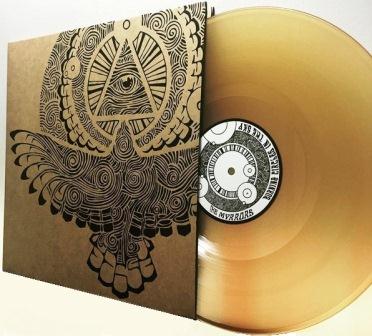 Nel 2008 esce il vostro esordio “Burning Circles in the Sky” su CDR per la vostra etichetta Strange Design Records, dove esprimete subito la vostra visione artistica multidimensionale, trainata da una solida matrice rock psichedelica verso una ricerca musicale senza confini anche esplorando culture vicine e lontane, ci puoi raccontare di questo primo periodo e della genesi dell’album?
Nel 2008 esce il vostro esordio “Burning Circles in the Sky” su CDR per la vostra etichetta Strange Design Records, dove esprimete subito la vostra visione artistica multidimensionale, trainata da una solida matrice rock psichedelica verso una ricerca musicale senza confini anche esplorando culture vicine e lontane, ci puoi raccontare di questo primo periodo e della genesi dell’album?
M (NR) – Come ti dicevo, non ci abbiamo ragionato molto e parecchio materiale venne rielaborato da registrazioni di demo fatte per dare alla band una sorta di un’identità nel suo primo anno di vita. E’ una specie di strana miscela di tutto ciò che ero in quel momento filtrata attraverso un paio di musicisti altamente inesperti cercando di imparare come registrare la musica. Allora i Myrrors si muovevano solo suonando nella valle di Phoenix, facendo bizzarre esibizioni nelle gallerie d’arte e suonando nei negozi di dischi per i nostri amici e quant’altro, senza alcun pensiero reale per il futuro della band. Poi ci siamo tutti diplomati alla scuola superiore e ognuno è andato per la sua strada, nessuno si aspettava con il nostro disco di fare qualcosa o andare da qualche parte!
In otto anni dalla sua uscita, “Burning Circles in the Sky” è stato ristampato varie volte da diverse etichette mettendo in risalto anche il progetto grafico e diventando uno dei cult album degli anni 2010. Come è stato il vostro incontro con queste etichette e quanto questo rapporto ha stimolato la vostra crescita artistica?
M (NR) – Rewolfed Gloom è stata una delle prime etichette ad offrirsi per la ristampa dell’album contattandoci come Merlin Nose, etichetta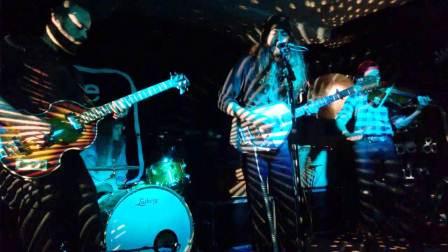 dedicata alla musica folk psichedelica, dicendoci che volevano che noi fossimo la prima band sulla loro nuova sub-label. Non so se poi ci sono stati altri titoli in realtà. Subito dopo abbiamo cominciato a lavorare per la sua uscita. Nel contempo Casper di Fuzz Club Records si mise in contatto sia per la ristampa che per contribuire ad una serie di split singles dieci pollici che stavano avviando. Abbiamo finito per fare una versione serigrafata “deluxe” con Fuzz Club in concomitanza con la versione standard di Rewolfed Gloom. La versione Cardinal Fuzz è una edizione limitata su cui abbiamo lavorato con Dave Cambridge e Sam Giles nel periodo in cui uscì anche “Solar Collector”. Parlando francamente, non sono davvero stato del tutto soddisfatto con una qualsiasi delle ristampe, in parte (e questo non potrà mai essere risolto) perché i master di quel disco sono stati persi da molto tempo. Tutte le ristampe realizzate finora sono state ottenute dal CDR originale. Questo album avrebbe un disperato bisogno di una seria revisione del suono. Il nostro rapporto con tutte queste etichette è stato stimolante in un modo o nell’altro. Rewolfed Gloom ci ha guidato verso la reincarnazione, Cardinal Fuzz ci ha collegato con la scena europea underground psychedelica e Fuzz Club ci ha aiutato a organizzare il nostro tour europeo offrendoci una sorta di seconda casa con base a Londra.
dedicata alla musica folk psichedelica, dicendoci che volevano che noi fossimo la prima band sulla loro nuova sub-label. Non so se poi ci sono stati altri titoli in realtà. Subito dopo abbiamo cominciato a lavorare per la sua uscita. Nel contempo Casper di Fuzz Club Records si mise in contatto sia per la ristampa che per contribuire ad una serie di split singles dieci pollici che stavano avviando. Abbiamo finito per fare una versione serigrafata “deluxe” con Fuzz Club in concomitanza con la versione standard di Rewolfed Gloom. La versione Cardinal Fuzz è una edizione limitata su cui abbiamo lavorato con Dave Cambridge e Sam Giles nel periodo in cui uscì anche “Solar Collector”. Parlando francamente, non sono davvero stato del tutto soddisfatto con una qualsiasi delle ristampe, in parte (e questo non potrà mai essere risolto) perché i master di quel disco sono stati persi da molto tempo. Tutte le ristampe realizzate finora sono state ottenute dal CDR originale. Questo album avrebbe un disperato bisogno di una seria revisione del suono. Il nostro rapporto con tutte queste etichette è stato stimolante in un modo o nell’altro. Rewolfed Gloom ci ha guidato verso la reincarnazione, Cardinal Fuzz ci ha collegato con la scena europea underground psychedelica e Fuzz Club ci ha aiutato a organizzare il nostro tour europeo offrendoci una sorta di seconda casa con base a Londra.
La versione CD del 2014 su Cardinal Fuzz contiene due inediti di matrice etno- psichedelica: ‘Ayllu’ e ‘Pyramids’, anche loro appartengono al periodo dell’album? Titoli con riferimenti ai nativi americani, da cosa nasce il vostro interesse?
psichedelica: ‘Ayllu’ e ‘Pyramids’, anche loro appartengono al periodo dell’album? Titoli con riferimenti ai nativi americani, da cosa nasce il vostro interesse?
M (NR) – ‘Pyramids’ precede l’album ed è una improvvisazione in trio dal vivo che ci è capitato di registrare e inizialmente pubblicato in free download online durante la ‘prima infanzia’ della band. Non ho idea da dove sia uscito il nome, probabilmente solo qualche titolo abbozzato e poi rimasto. ‘Ayllu’ è stato registrato un po’ dopo “Burning Circles in the Sky” quindi ha una fedeltà migliore dato che avevamo ancora il master. Il titolo viene da un interesse per le società agricole strutturate in comunità del Sud America e dal classico “Land or Death” di Hugo Blanco sul movimento rivoluzionario contadino Peruviano negli anni settanta.
Nel 2013 pubblicate l’EP “Solar Collector”, in origine una cassetta poi ristampata da Cardinal Fuzz con l’aggiunta di ‘Escape Attempt’. Un disco di musica strumentale dove il suono si dilata anche nella durata delle vostre composizioni come una percezione di spazio permanente da cui risalta un  potente fraseggio chitarristico denso di effetti. L’inizio di una nuova fase del vostro suono oltre la forma canzone, ce ne puoi parlare?
potente fraseggio chitarristico denso di effetti. L’inizio di una nuova fase del vostro suono oltre la forma canzone, ce ne puoi parlare?
M (NR) – “Solar Collector” è una raccolta di jam da prove in studio messe insieme in un giorno o due. Ho duplicato un centinaio di cassette con copertine fotocopiate vendendole on-line e ai concerti con l’idea di annunciare il nostro ritorno e lasciarci il tempo di lavorare al secondo album vero e proprio. “Burning Circles in the Sky” non fornisce veramente un quadro preciso della band così come siamo quando suoniamo dal vivo dove improvvisiamo sviluppando il suono da una base di poche note. Quindi penso che “Solar Collector” potrebbe essere un naturale ritorno del gruppo come si presenta oggi nelle sue capacità live. Siamo stati felici quando Dave Cambridge di Cardinal Fuzz l’ha stampato su vinile anche se non stavamo pensando molto alla musica in quel momento. ‘Escape Attempt’ è stato registrato in quei giorni nel corso di una session diversa, seguendo più o meno la stessa formula a parte il fatto che Grant sovraincise il sassofono.
In questo lavoro emerge un’altra componente molto forte del vostro pensiero verso tutto ciò che è Natura. Ci puoi parlare del vostro rappresentare una relazione tra suono e  natura, qualcosa ispirato anche da luoghi che vi circondano e che avete visitato o dall’esigenza di prendere una posizione contro la minaccia ambientale che incombe sul pianeta?
natura, qualcosa ispirato anche da luoghi che vi circondano e che avete visitato o dall’esigenza di prendere una posizione contro la minaccia ambientale che incombe sul pianeta?
M (NR) – Da molto prima dell’inizio del gruppo ho avuto un profondo interesse per il rapporto dell’uomo con la natura, non esattamente come punto di vista accademico, ma forse da una visione più un viscerale e (inevitabilmente) politica. C’è qualcosa di più del piacere di camminare nel deserto o dormire sotto i pini e sentirsi avvolti nei cicli biologici della natura che ci governano. Questo ha probabilmente più di un influenza sulla nostra musica, una sorta di canalizzazione sonica di cicli naturali polarizzati dalla vita del deserto di Sonora. Ed è difficile non infuriarsi quando vedi come così tante persone siano ignoranti dell’importanza dei nostri “legami” con il mondo naturale e del tipo di degrado che incombe intorno alle nostre case. Siamo tanto parte della natura quanto gli alberi di Palo Verde o le formiche che attraversano il cortile, che si voglia o meno. Alla fine saremo tutti riassorbiti dal pianeta in ogni modo, questo è inevitabile, ma se vogliamo sopravvivere molto più a lungo come una specie vitale allora è meglio iniziare un po’ di fondamentale rivalutazione culturale. Molte delle canzoni che ho scritto per il gruppo affrontano questi temi da vari punti di vista.
Nel 2014 è riconducibile a voi anche un’altra attività editoriale con la fondazione di Sky Lantern Records, 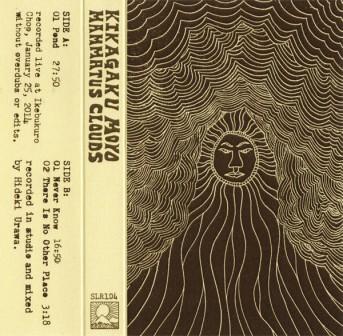 etichetta pubblicata su cassette e DL attraverso bandcamp. Una visione radical underground con gruppi provenienti da tutto il mondo presentati in un progetto artistico tra suggestive grafiche e drone rock music. Che storia ha questa etichetta e come è nata la scelta dei gruppi?
etichetta pubblicata su cassette e DL attraverso bandcamp. Una visione radical underground con gruppi provenienti da tutto il mondo presentati in un progetto artistico tra suggestive grafiche e drone rock music. Che storia ha questa etichetta e come è nata la scelta dei gruppi?
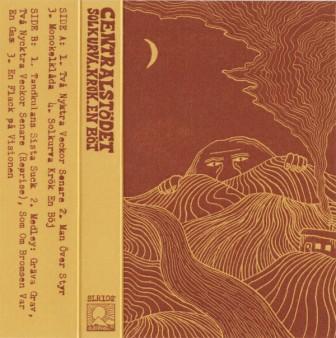 M (NR) – Sky Lantern era di fatto un’estensione del mio navigare in rete con la scoperta di tutti questi artisti sperimentali incredibili da tuttoil mondo che stavano facendo proprio il tipo di musica che volevo ascoltare. Se non fosse che nessuno sembrava prestare molta attenzione! Così ho pensato di provare e vedere se potevo aiutarli ad acquisire un po’ di contatti interessati ai loro suoni qui negli Stati Uniti. Le cassette sono state scelte a causa della convenienza del formato, se fossi stato in una posizione economica più comoda mi sarebbe piaciuto dedicare la realizzazione al vinile. L’etichetta è stata inattiva per un lungo periodo a causa dei miei impegni altrove, ma spero di riattivarla quest’anno con alcuni nuovi suoni.
M (NR) – Sky Lantern era di fatto un’estensione del mio navigare in rete con la scoperta di tutti questi artisti sperimentali incredibili da tuttoil mondo che stavano facendo proprio il tipo di musica che volevo ascoltare. Se non fosse che nessuno sembrava prestare molta attenzione! Così ho pensato di provare e vedere se potevo aiutarli ad acquisire un po’ di contatti interessati ai loro suoni qui negli Stati Uniti. Le cassette sono state scelte a causa della convenienza del formato, se fossi stato in una posizione economica più comoda mi sarebbe piaciuto dedicare la realizzazione al vinile. L’etichetta è stata inattiva per un lungo periodo a causa dei miei impegni altrove, ma spero di riattivarla quest’anno con alcuni nuovi suoni.
Nel 2015 esce “Arena Negra”, quattro lunghe composizioni che orientano ulteriormente il vostro suono verso dinamiche cicliche, una drone music potente e meditativa. ‘Juanito Laguna Duerme con Los Grillos’ ci introduce all’arte visionaria di Antonio Berni, ‘The Forward Path: Emergence, Distant Traveller, Permanent Revolution’ sembra uscire dal ‘Theatre of Eternal Music’ di La Monte Young (che spesso citate nelle vostre interviste). Ci racconti la genesi di questo album, e il significato del suo titolo?
M (NR) – “Arena Negra” è stato un work in progress per un certo tempo essendo il primo vero album del gruppo riformato. Ha attraversato un lungo 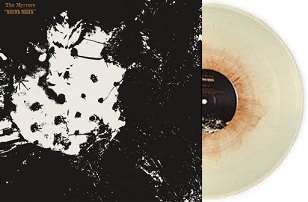 periodo di lavoro dove abbiamo cercato di capire l’identità della band e registrato molte ore di improvvisazioni e demo, cercando di filtrare quanto di meglio siamo riusciti a trovare. La canzone ‘Arena Negra’ credo sia stato il primo brano scelto, anche se aveva una precedente incarnazione in una forma molto diversa che suona come una sorta di jam Amon Düül II o qualcosa del genere. Il titolo viene da testi che si riferiscono ai diseredati, o come Frantz Fanon direbbe “I dannati della Terra”. Juanito Laguna era una sorta di mio contributo al pantheon delle canzoni basate sulla figura di Berni, come Hamlet Quintana di ‘Juanito Laguna Remonte Un Barrillete’ interpretato magnificamente nel primo LP di Inti Illimani. ‘The Forward Path’ è stato sicuramente influenzato dal Theater of Eternal Music, come la maggior parte della nostra musica in questi giorni, anche se i Taj Mahal Travellers hanno avuto un impatto pari in riferimento alla sezione centrale del titolo.
periodo di lavoro dove abbiamo cercato di capire l’identità della band e registrato molte ore di improvvisazioni e demo, cercando di filtrare quanto di meglio siamo riusciti a trovare. La canzone ‘Arena Negra’ credo sia stato il primo brano scelto, anche se aveva una precedente incarnazione in una forma molto diversa che suona come una sorta di jam Amon Düül II o qualcosa del genere. Il titolo viene da testi che si riferiscono ai diseredati, o come Frantz Fanon direbbe “I dannati della Terra”. Juanito Laguna era una sorta di mio contributo al pantheon delle canzoni basate sulla figura di Berni, come Hamlet Quintana di ‘Juanito Laguna Remonte Un Barrillete’ interpretato magnificamente nel primo LP di Inti Illimani. ‘The Forward Path’ è stato sicuramente influenzato dal Theater of Eternal Music, come la maggior parte della nostra musica in questi giorni, anche se i Taj Mahal Travellers hanno avuto un impatto pari in riferimento alla sezione centrale del titolo.
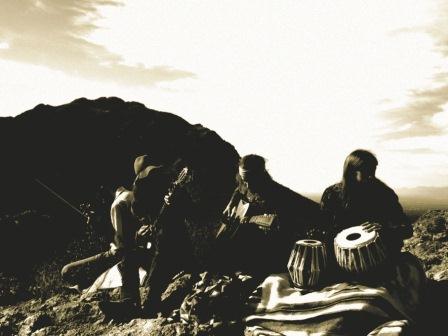 In ‘Arena Negra’ l’elemento acustico del vostro suono fluisce nello spazio elettrico introducendo vari strumenti anche autocostruiti e interessanti sviluppi etno-cosmici di orientamento jazz. Ci puoi parlare di questo vostro approccio al suono acustico intensificato anche dall’uso di percussioni, fiati e violino? La percezione è quella di uno sviluppo spontaneo in cerca di una libertà espressiva attraverso una musica più improvvisata, sei d’accordo?
In ‘Arena Negra’ l’elemento acustico del vostro suono fluisce nello spazio elettrico introducendo vari strumenti anche autocostruiti e interessanti sviluppi etno-cosmici di orientamento jazz. Ci puoi parlare di questo vostro approccio al suono acustico intensificato anche dall’uso di percussioni, fiati e violino? La percezione è quella di uno sviluppo spontaneo in cerca di una libertà espressiva attraverso una musica più improvvisata, sei d’accordo?
M (NR) – La combinazione di suoni acustici ed elettrici è importante per noi, anche se l’uso degli strumenti che citi nasce dall’amore per musiche acustiche varie come il free jazz, la Nueva Canción Chilena e diverse tradizioni folk dell’Asia centrale. In un certo senso queste influenze sono maggiori su di noi rispetto alla maggior parte della musica di base rock and roll. Ma sono assolutamente d’accordo con questa interpretazione, il centro di tutto è l’improvvisazione, è la ricerca di una sempre maggiore ispirazione. Se dovessi dare alla nostra musica un’etichetta, sarei molto contento di chiamarla ‘trance music’. Almeno questo è ciò che è per noi.
In questi due anni avete intrapreso una densa attività live partecipando ad importanti festivals come il Liverpool International Festival of Psychedelia e il Levitation di Austin, l’anno scorso siete stati anche in Italia con diverse date durante un lungo tour europeo. Ci sono posti di cui conservi un ricordo particolare sia sul piano musicale che umano?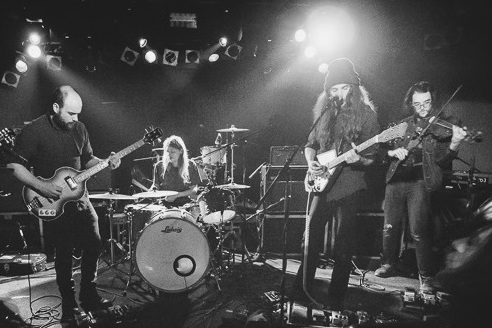
M (NR) – In Italia è stato molto divertente l’anno scorso, anche se siamo stati particolarmente sopraffatti dalla risposta che abbiamo ottenuto in Grecia, dove abbiamo in qualche modo riempito i locali oltre le loro capacità! Ero soprattutto entusiasta in quanto è uno dei miei paesi preferiti per trascorrerci del tempo e le persone sono magnifiche. Levitation è stato superlativo, perché era la prima volta che suonavamo a un grande festival anche se quando abbiamo fatto Le Guess Who a Utrecht eravamo un po’ intimiditi dalla enormità del tutto, ci sentivamo come in un sogno surreale! Avevamo un tecnico per la movimentazione degli strumenti e un camerino con assistente. Poi abbiamo finito per suonare e successivamente vedere Keiji Haino e Magma! Davvero, un’esperienza parecchio strana per un gruppo di ragazzi trasandati del deserto in giro per la prima volta in Europa.
Dopo “Arena Negra” sono usciti diversi singoli tra cui “Comrades / 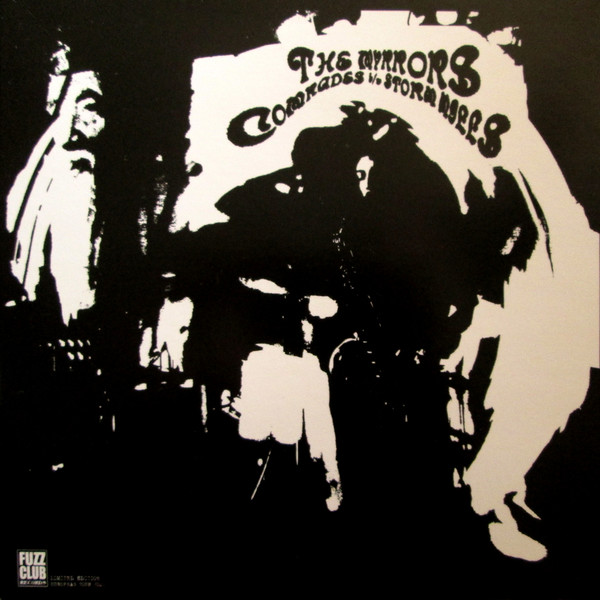 Storm Mills” e poi due split con i londinesi Cult of Dom Keller e i liverpooliani Strange Collective, infine un singolo allegato al n.10 del magazine Optical Sounds. Che storie hanno queste canzoni? E’ materiale nuovo oppure originato dalle sessions di “Arena Negra”?
Storm Mills” e poi due split con i londinesi Cult of Dom Keller e i liverpooliani Strange Collective, infine un singolo allegato al n.10 del magazine Optical Sounds. Che storie hanno queste canzoni? E’ materiale nuovo oppure originato dalle sessions di “Arena Negra”?
M (NR) – Registriamo costantemente, così abbiamo sempre una ricchezza di outtakes e quant’altro, alcuni 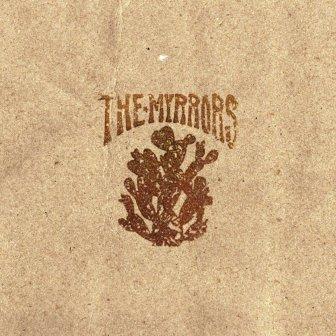 dei quali sono sicuramente molto meglio di altri. Lo split con Cult of Dom Keller di cui ti parlavo in precedenza è stato uno dei primi demo / outtake dalle sessions di Arena Negra, elementi di ciò che poi effettivamente sono stati ri-assemblati per le parti di ‘The Forward Path’. I singoli per Optical Sounds e God Unkown sono registrazioni istantanee che ci sono piaciute durante le prove e tra le varie sessions. Il 45 ‘Comrades’ viene da un paio di tracce lo-fi stranamente registrate che abbiamo messo insieme come realizzazione esclusiva per tour Europeo.
dei quali sono sicuramente molto meglio di altri. Lo split con Cult of Dom Keller di cui ti parlavo in precedenza è stato uno dei primi demo / outtake dalle sessions di Arena Negra, elementi di ciò che poi effettivamente sono stati ri-assemblati per le parti di ‘The Forward Path’. I singoli per Optical Sounds e God Unkown sono registrazioni istantanee che ci sono piaciute durante le prove e tra le varie sessions. Il 45 ‘Comrades’ viene da un paio di tracce lo-fi stranamente registrate che abbiamo messo insieme come realizzazione esclusiva per tour Europeo.
Ci racconti della partecipazione al progetto “For Nepal”, un doppio vinile che Evil Hoodoo Records sta realizzando a scopo benefico in sostegno alle popolazioni colpite dal devastante terremoto del 2015. Come è nata questa adesione e con che musica contribuirete?
M (NR) – Tempo fa Thom di Evil Hoodoo mi disse che stava facendo una compilation per beneficenza e alla fine ci chiese se volevamo partecipare. Siamo stati entusiasti e come sempre disponibili per un progetto del genere. Thom ha davvero lavorato sodo per raccogliere tutto e sono molto felice di vedere il progetto finito! Ha assemblato una raccolta di nomi notevole. La traccia con cui abbiamo contribuito è in realtà una rielaborazione di una vecchia base dal vivo risalente al periodo di ‘Burning Circles in the Sky’! Abbiamo sempre apprezzato quella versione e siamo contenti di avere finalmente una motivo per realizzarla.
Il 27 Maggio Beyond Beyond is Beyond realizzerà il nuovo album “Entranced Earth” di cui avete già rivelato qualche canzone su bandcamp come la bellissima title track dedicata a Sigumd Kvaloy, è davvero interessante come siete sempre riconoscenti ai vostri ‘spiriti guida’ anche nel farli conoscere attraverso la vostra musica. Cosa vi ha colpito nel pensiero del filosofo 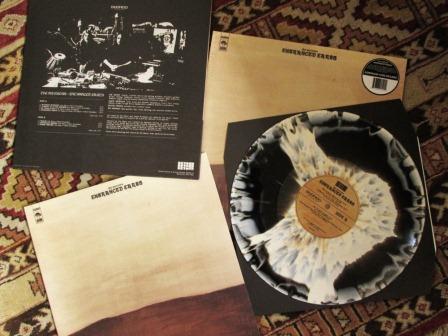 Norvegese? Ci puoi raccontare del percorso creativo che vi ha condotto alla realizzazione dell’album?
Norvegese? Ci puoi raccontare del percorso creativo che vi ha condotto alla realizzazione dell’album?
M (NR) – Credo che Sigmund Kvaløy abbia davvero una potente filosofia olistica, abbracciando ecologia profonda e azione politica radicale da un’interessante combinazione di interpretazione marxista e buddista. Avevo pensato molto ai suoi scritti per tutto il tempo in cui abbiamo iniziato a lavorare al nuovo disco e mi ha colpito al punto che in qualche modo ho voluto cercare di trasportare lo spirito del lavoro di Kvaløy da qualche parte sul disco. Mi piacerebbe che molti potessero leggere il suo lavoro che meriterebbe più titoli tradotti in inglese! E ‘molto difficile trovare uno qualsiasi dei suoi libri qui negli Stati Uniti.
Il processo di strutturare il nuovo album è stato molto diverso da quello di “Arena Negra”, almeno nel senso che è stata una fase molto rapida avendo già una serie di idee messe da parte precedentemente che abbiamo voluto provare e sviluppare. L’idea generale per “Entranced Earth” era di spogliare un po’ il suono di “Arena Negra” e approcciare lo stesso obiettivo da una diversa angolazione, con un accento più vibrante sul minimalismo forse. L’influenza del tardo Tony Conrad (riposa in pace) è stata fondamentale per il nuovo album. Credo che siamo stati anche più severi nella registrazione rispetto al precedente, possibile risultato della pratica musicale nell’ultimo anno e di una crescente consapevolezza nell’identità della band. Ma siamo davvero contenti di come si è rivelato. Credo che si aggiunge ad “Arena Negra”, piuttosto che ripeterlo, e probabilmente non saremmo riusciti a farlo se non avessimo provato comunque!
ALBUM
“Burning Circles In The Sky” (CDR, Strange Design Records) 2008 *
“Arena Negra” (LP & CD, Beyond Beyond Is Beyond Records) 2015
“Entranced Earth” (LP & CD, Beyond Beyond Is Beyond Records) 2016
SINGLES
“Ramona Parra /Nobody’s Children” (DL, Strange Design Records) 2013
“Solar Collector EP” (cassette, Strange Design Records) 2013 **
“2015 Southwest Tour EP” (CDR, Strange Design Records) 2015
“Comrades / Storm Mills” (7″, Fuzz Club Records) 2015
“Semillas Sembradas Pt 1 & 2” (7″ given with Optical Sounds magazine n.10) 2016
‘Cross Amber Antler’ (from the compilation CD “Open Your Mind”, Psyilocybin Sounds) 2009
‘Funeral Ark’ (from the 10″ split w/Cult Of Dom Keller, Fuzz Club Records) 2015
‘Wood Smoke Corona’ (from the 7″ split w/Strange Collective, God Unknown Records) 2016
V.A. “For Nepal” (2xLP, Evil Hoodoo)
NOTES
* Reissued on Rewolfed Gloom (LP, 2014), Cardinal Fuzz (CD, 2014), Fuzz Club (LP & CD, 2014 & 2015)
** Reissued on Cardinal Fuzz (LP & CD, 2014)




English version…
THE MYRRORS
ENTRANCED MUSIC
On the trail of Myrrors from Tucson (Arizona). From the Sonoran Desert along the roads of the world including South America, Europe and Asia. A journey on the move since 2007 on the developments of a passionate research in re-imagining the idea of psychedelic music to offer food for thought and new coordinates of their sound today expressed by: Nik Rayne (acoustic guitar, electric, voice, drones), Miguel Urbina (violin), Grant Beyschau (drums, percussion, saxophone, flute, clarinet) and Kellan Fortier (bass). On the eve of their new highly anticipated third album “Entranced Earth” we retrace the story in this pleasant conversation via web with one of the founders: Nik Rayne
When did you founded, could you tell us something about your beginnings and where does the name Myrrors, the idea to start a band?
M (NR) – The band formed about nine years ago as just a collective of a few teenage friends who were interested in making music inspired by all the crazy psychedelic records we were discovering at the time. The band name was just an unfortunate suggestion that stuck with us through our inability to think of anything worthwhile. We recorded the album Burning Circles in the Sky within that first year of existence, and that was basically just a loose collection of songs and studio experiments I was tossing together in my spare time to try and give us some structured material to perform live.
From various interviews I read that you have a remarkable musical knowledge, is it the result of a personal research or triggered by particular situations? What are your sources of inspiration? What are you listening to these days? The Sweden band Hills interviewed two months ago mentioned The Myrrors among their favorite bands…
M (NR) – I’m a pretty obsessive music listener as well as musician, and am always digging for interesting new sounds and international creative undergrounds. The list of influences is almost endless and changes from day to day depending on what we’re feeling particularly inspired by or exploring at that time. Right now I’m listening to a lot of Greek demotika and keep spinning the last record by Masaki Batoh’s inspirational new group The Silence…and I know Grant [the drummer] has been completely burying himself in new age cassettes. And yeah, we were really happily surprised when we saw that interview with Hills, as they are absolutely one of our favorite bands as well! They actually came out to our show with Centralstödet last autumn in Gothenburg and they were really a joy to talk to. I would love to get the chance to play with them in the future sometime, though I know they are all quite busy with various projects and the drummer is newly a mother!
How your music is influenced by the places from which you come? Since the 1980s Tucson offered to the underground galaxy important bands including Black Sun Ensemble. Do you have memories of some musicians, friendships, inspirations?
M (NR) – Honestly I think that our music is far more influenced by Arizona as a natural environment than it is by it as an artistic community. We have always been black sheep down here, outside whatever you might define as the current music “scene.” Sun City Girls is probably the main Arizona band to have had any real influence on us, and of course their days stomping around here came a little before our time. I’m not very familiar with the Black Sun Ensemble guys, though I’ve seen them perform twice under their reunited guise of Cobracalia.
In 2008 you released the debut album “Burning Circles in the Sky” on CDr through your label Strange Design Records, where you express right away your artistic multidimensional vision, driven by solid psychedelic rock basis towards a music research without borders also exploring near and distant cultures, could you tell us about the genesis of the album and about this first period of your life as a band?
M (NR) – As mentioned previously, there wasn’t that much thought put into the first album, a lot of it was just re-recordings of demos that I had made to give the band some sort of an identity in its first year of life. It’s kind of just a weird stew of whatever I was into at the time filtered through a couple of highly inexperienced musicians trying to learn how to record music. At the time The Myrrors were just playing around the Phoenix valley, doing funky art gallery gigs and playing at record stores and for our friends and whatnot, without any real thought to the future of the band. Then we all graduated high school and went our separate ways, not expecting our record to do anything or go anywhere!
In eight years after its release, “Burning Circles in the Sky” has been reissued in various editions by 3 different labels (Fuzz Club, Rewolfed Gloom, Cardinal Fuzz), highlighting also the beautiful artwork and becoming one of the cult albums of 2000 years. Could you tell us about your meeting with these labels and how this relationship has stimulated your growth as an artist?
M (NR) – Rewolfed Gloom was one of the first labels to get in touch with us about reissuing the record. Actually, at that time it was Merlin’s Nose, focusing on psychedelic folk music, but they said they wanted us to be the first band on their new sub-label…not sure if there have been any more since then, actually. Soon after we started working that out, Casper over at Fuzz Club Records got in touch as well about doing the reissue as well as about contributing to a split ten-inch series they were starting. We ended up doing a “deluxe,” screen-printed version of the album with Fuzz Club concurrent with the standard issue Rewolfed Gloom one. The Cardinal Fuzz release was a limited edition thing we worked out with Dave Cambridge and Sam Giles around the time that Solar Collector came out. Speaking frankly, I haven’t really been entirely happy with any of the reissues so far, in part (and this can’t really ever be remedied) because the master tapes of that record were lost long ago. Everything released so far has had to be dubbed from the original CDr issue. That record is desperately in need of a serious sonic overhaul. Our relationship with these labels have all been stimulating in one way or another. Rewolfed Gloom guided us towards reincarnation, Cardinal Fuzz connected us with the European underground psych scene, and Fuzz Club helped us organize our European Tour and give us a sort of second home base in London.
The CD edition of 2014 on Cardinal Fuzz includes two extra tracks based on ethno-psychedelic themes: ‘Ayllu’ and ‘Pyramids’, are them from the same recording sessions of the album? The title of these songs seems to refer to ancient civilizations like native Americans or pre-Columbian cultures, could you tell us what originated your interest about it?
M (NR) – The Pyramids track predates the record, I think, and is just a live trio improvisation that we happened to record and originally put out for free online in the band’s earliest infancy. No idea where the name for that came from, probably just some throwaway title we stuck on there. Ayllu was recorded a little after Burning Circles, hence it’s better fidelity as we still had the master for that one. The title of that one does come from an interest in South American communally-structured agrarian societies and Hugo Blanco’s classic “Land or Death” about the Peruvian guerrilla movement in the seventies.
In 2013 you released the “Solar Collector” EP on your label Strange Design Records, originally a cassette then reissued on vinyl by Cardinal Fuzz with the addition of ‘Escape Attempt’. A work of instrumental music where the sound expanded also in the length of your compositions like a perception of permanent space from which emerges a powerful guitar phrasing in a density of effects. Is it the beginning of a new phase of your sound beyond the song structure, could you tell us?
M (NR) – The Solar Collector release was just a collection of rehearsal room jams pieced together in a day or two. I dubbed a hundred cassette copies and made some photocopy inserts and we sold them online and at shows to kind of announce our return and bide us a little bit of time while we worked on our proper second full-length. Burning Circles was never really an accurate picture of the band as we performed live, we generally just improvised and jammed out on one or two notes. So I suppose that the tape could be seen as a natural return of the actual group as it existed in a performing capacity. We were happy when Dave Cambridge at Cardinal Fuzz pressed it on vinyl, though we didn’t think much of the music at the time. Escape Attempt was cut during a different session around the same time, following pretty much the same formula aside from the fact that Grant had done a simple saxophone overdub on top of everything.
In this work emerges your devotion for the Nature, like a feeling, a way of life. Could you tell us about your idea to represent a relationship between sound and Nature? Something also inspired by the places where you live or that you visited? The urgency to take a stand against the serious environmental threat looming over our planet?
M (NR) – Since long before the beginning of the group I’ve had a deep interest in mankind’s relationship to nature, not exactly from any kind of academic standpoint but maybe more of a visceral and (inevitably) political one. There is little I enjoy more than walking in the desert or sleeping beneath the pines and feeling enveloped in the organic cycles of nature which command us. That probably has as much of an influence on our music as anything, a sort of sonic channeling of natural cycles grounded in Sonoran life. And it’s hard not to become enraged when you see how ignorant so many people are of the importance of our “ties” to the natural world and the kind of degradation that we are heaping upon our home. We are as much a part of nature as the palo verde or the ants crawling across the yard, whether we want to be or not. Eventually we will all be swallowed back up by the planet anyways, that’s inevitable, but if we want to survive much longer as a viable species then we better start some fundamental cultural re-evaluation. Many of the songs I’ve written for the group touch on these things from one point or another.
In 2014 is attributable to you also another publishing activity with the foundation of Sky Lantern Records, a cassette label through Bandcamp. A radical underground vision, with bands from all over the world presented in an artistic project between evocative artworks and drone rock music. Could you tell us about the label, the choice to issue on cassette format and what led you into those bands?
M (NR) – Sky Lantern was just an extension of my accidental networking and discovery of all these incredible experimental artists from around the world that were making just the kind of music that I was wanting to hear. Except nobody seemed to be paying much attention! So I though I’d try and see if I could help them gain a little bit of a foothold here in the States, kind of try and leverage my position to get some of these sounds out there. Cassettes were chosen due to the affordability of the format, more than anything else, if I had been in a more comfortable economic position I’d have loved to focus on vinyl releases. The label has been inactive for a long time due to my commitments elsewhere, but hopefully I’ll be re-activating the label sometime this year with some new sounds.
In 2013 you released “Arena Negra” on Beyond Beyond is Beyond Records, four long compositions in a further development of your sound towards cyclic dynamics, an intense and meditative drone music. ‘Juanito Laguna Duerme con Los Grillos’ (sung in Spanish) introduces to the visionary art of Antonio Berni, ‘The Forward Path: Emergence, Distant Traveller, Permanent Revolution’ seems to come out from the Theater of Eternal Music of La Monte Young (often mentioned in your interviews). Could you tell us about the genesis of this album and the meanings of its title?
M (NR) – Arena Negra was a work in progress for a while, being the first real reunion album by the group. It went through a long period of labor as we tried to figure out the band’s identity and recorded many hours worth of improvisations and demos, trying to filter out whatever gold we could find among the shit. The track Arena Negra was, I think, the first song selected for the record, though it had an earlier incarnation in a much different form, sounding like some sort of Amon Düül II jam or something. The title comes from the lyrics which relate to the dispossessed, or as Frantz Fanon would put it, the “wretched of the Earth.” Juanito Laguna was sort of my contribution to the pantheon of songs based on Berni’s figure, such as Hamlet Quintana’s “Juanito Laguna Remonte Un Barrillete,” interpreted so beautifully on Inti Illimani’s first LP. The Forward Path was certainly influenced by the Theater of Eternal Music, as is most of our music these days, though Taj Mahal Travellers had an equal impact in some oblique way, as referenced explicitly by the title of the middle section.
In ‘Arena Negra’ the acoustic element of your sound flows in the electric space by introducing various instruments also self-built and interesting jazz oriented ethno-cosmic themes. Could you tell us about your approach to the acoustic sound even intensified by the use of percussion, sax, flute and violin? The perception is that of a spontaneous development in search of a freedom of expression through a more improvised music, do you agree?
M (NR) – The combination of acoustic and electric sounds is important to us, though the use of those instruments mentioned also stems from a love of diverse acoustic musics like free jazz, Nueva Canción Chilena, and different Central Asian folk traditions. In one sense these are bigger influences on us than most rock and roll based music. But I definitely agree with that interpretation, everything at it’s heart is improvisation is search of greater and greater inspiration. If I had to give our music a label, I would be most happy with “trance music” I think. At least that’s what it is for us.
In the past two years you have undertaken a dense live activity, participating in important festivals such as Levitation in Austin, last year you were also in Italy with different dates during a long European tour. There are places of which kept a special remembrance on both the musical and human level?
M (NR) – Italy was a lot of fun last year, though we were particularly overwhelmed by the response we got in Greece, where we somehow filled venues over capacity! Especially thrilled as it is one of my favorite countries to spend time in, the land there and the people are beautiful. Levitation was rad, as it was our first time playing at a larger festival, though when we did Le Guess Who in Utrecht we were kind of intimidated by the enormity of it all, it just felt like some surreal dream! We had our own loading dock manager and green room assistant, and then we finish playing and go watch Keiji Haino and Magma on the next stage! Really, really weird experience for a bunch of scruffy desert kids touring the continent for the first time.
After “Arena Negra” you released various singles for various labels like “Comrades/Storm Mills” (dedicated to Ho Chi Minh) then two split singles with London band Cult of Dom Keller and Liverpool band Strange Collective and finally a single given with the new issue of Optical Sounds magazine. What’s the story behind these tracks? Is brand new material, or originated from the sessions that brought us Arena Negra?
M (NR) – We’re constantly recording so we always have a wealth of outtakes and whatnot, some of which are certainly far better than others. The Cult of Dom Keller split was the one I mentioned earlier that Casper at Fuzz Club asked us to do back when they did the deluxe Circles reissue. That cut was one of the early demo or outtake tracks from the Arena Negra sessions, in fact I think elements of that one actually ended up being re-assembled for parts of The Forward Path. The Optical Sounds and God Unknown tracks are sort of one-off recordings cut during rehearsals and down-time sessions that we liked. And the Comrades 45 was a pair of sort of weirdly recorded lo-fi tracks that we put together for an exclusive European tour release.
Could you tell us about the participation to the charity project “For Nepal”, a double vinyl announced by Evil Hoodoo Records to help the people affected by the devastating earthquake in 2015. How your joining is come and what will be your contribute in music?
M (NR) – I had talked to Thom from Evil Hoodoo about the project awhile back when he first mentioned that he was doing a benefit compilation, and eventually he ended up asking whether we wanted to submit a track, which we were thrilled to do as we are always willing to put something together for something like that. Thom has really worked his ass off putting this whole thing together and I know I’m really excited to see the finished project! He’s assembled a remarkable lineup. The cut we contributed is actually a several year old re-recording of a live staple of ours dating from around the time of Burning Circles in the Sky! So a convoluted history to that one, but we had always liked that version and were glad to finally get an excuse to release it into the world.
Next 27 May, Beyond Beyond is Beyond Records will release your new album “Entranced Earth” by which you have already revealed a few songs on Bandcamp as the beautiful title track dedicated to Sigmund Kvaløy, it’s really interesting how you are always grateful to your ‘spirit guides’ even in make them known through your music. What impressed you in the thinking of the Norwegian philosopher? Can you tell us the creative journey that led to the making of the album?
M (NR) – Well, I feel like Sigmund Kvaløy really has a powerful holistic philosophy, embracing deep ecology and radical political action from his own rather interesting combination of Marxist and Buddhist interpretation. I had been thinking a lot about his writing around the time that we were starting work on the new record and I was struck that in some way I wanted to try and capture what I saw the spirit of Kvaløy’s work somewhere on the album. I also feel like more people should read his work, or at the very least translate more of it into English! It is very difficult to find any of his books here in the States. But the process of putting together the new record was very different from that of Arena Negra, at least in that it was a very quick process and we already had a store of ideas set aside from the previous record that we wanted to try and tackle on this one.
The general idea for Entranced Earth was to strip back a little bit of the sound of Arena Negra and approach the same goal from a different angle, with a more strident emphasis on minimalism perhaps – the influence of the late Tony Conrad, rest in peace, was fundamental to the new album. I think we were also a lot tighter recording this record than we were on the last, presumable the result of how much we were playing out last year and a growing comfort in the band’s identity. But we’re really happy with how this one turned out. I think it adds to Arena Negra rather than repeats it, which we probably couldn’t have done if we tried anyways!